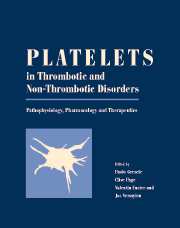Book contents
- Frontmatter
- Contents
- List of contributors
- Editors' preface
- PART I PHYSIOLOGY
- 1 History of platelets
- 2 Production of platelets
- 3 Morphology and ultrastructure of platelets
- 4 Platelet heterogeneity: physiology and pathological consequences
- 5 Platelet membrane proteins as adhesion receptors
- 6 Dynamics of the platelet cytoskeleton
- 7 Platelet organelles
- 8 Platelet receptors for thrombin
- 9 Platelet receptors: ADP
- 10 Platelet receptors: prostanoids
- 11 Platelet receptors: collagen
- 12 Platelet receptors: von Willebrand factor
- 13 Platelet receptors: fibrinogen
- 14 Platelet signalling: GTP-binding proteins
- 15 Platelet phospholipases A2
- 16 Roles of phospholipase C and phospholipase D in receptor-mediated platelet activation
- 17 Platelet signalling: calcium
- 18 Platelet signalling: protein kinase C
- 19 Platelet signalling: tyrosine kinases
- 20 Platelet signalling: cAMP and cGMP
- 21 Platelet adhesion
- 22 The platelet shape change
- 23 Aggregation
- 24 Amplification loops: release reaction
- 25 Amplification loops: thromboxane generation
- 26 Platelet procoagulant activities: the amplification loops between platelets and the plasmatic clotting system
- 27 Platelets and chemotaxis
- 28 Platelet–leukocyte interactions relevant to vascular damage and thrombosis
- 29 Vascular control of platelet function
- PART II METHODOLOGY
- PART III PATHOLOGY
- PART IV PHARMOLOGY
- PART V THERAPY
- Afterword: Platelets: a personal story
- Index
- Plate section
14 - Platelet signalling: GTP-binding proteins
from PART I - PHYSIOLOGY
Published online by Cambridge University Press: 10 May 2010
- Frontmatter
- Contents
- List of contributors
- Editors' preface
- PART I PHYSIOLOGY
- 1 History of platelets
- 2 Production of platelets
- 3 Morphology and ultrastructure of platelets
- 4 Platelet heterogeneity: physiology and pathological consequences
- 5 Platelet membrane proteins as adhesion receptors
- 6 Dynamics of the platelet cytoskeleton
- 7 Platelet organelles
- 8 Platelet receptors for thrombin
- 9 Platelet receptors: ADP
- 10 Platelet receptors: prostanoids
- 11 Platelet receptors: collagen
- 12 Platelet receptors: von Willebrand factor
- 13 Platelet receptors: fibrinogen
- 14 Platelet signalling: GTP-binding proteins
- 15 Platelet phospholipases A2
- 16 Roles of phospholipase C and phospholipase D in receptor-mediated platelet activation
- 17 Platelet signalling: calcium
- 18 Platelet signalling: protein kinase C
- 19 Platelet signalling: tyrosine kinases
- 20 Platelet signalling: cAMP and cGMP
- 21 Platelet adhesion
- 22 The platelet shape change
- 23 Aggregation
- 24 Amplification loops: release reaction
- 25 Amplification loops: thromboxane generation
- 26 Platelet procoagulant activities: the amplification loops between platelets and the plasmatic clotting system
- 27 Platelets and chemotaxis
- 28 Platelet–leukocyte interactions relevant to vascular damage and thrombosis
- 29 Vascular control of platelet function
- PART II METHODOLOGY
- PART III PATHOLOGY
- PART IV PHARMOLOGY
- PART V THERAPY
- Afterword: Platelets: a personal story
- Index
- Plate section
Summary
Introduction
To respond to extracellular signals, platelets possess different types of surface receptors for stimulatory and inhibitory ligands. Surface receptors can be classified in three groups each possessing a specific property by which information is relayed through the plasma membrane. These are: (i) G-protein linked receptors, (ii) enzyme linked receptors and, (iii) ion channel-linked receptors. G-protein linked receptors are seven transmembrane receptors that relay the stimulus to high molecular weight, heterotrimeric GTP-binding regulatory proteins (G-proteins in short) consisting of three polypeptides, an α-, a β- and a γ- subunit. Enzyme linked receptors have a single transmembrane domain and contain a cytosolic tail with an intrinsic enzyme activity or that associates directly with an enzyme. They start signalling cascades that involve a second class of GTP-binding proteins which are low molecular weight, monomeric GTPases (small GTPases in short). Ion channel linked receptors respond directly to ligand binding by opening a channel pore resulting in single channel currents.
Both G-proteins and small GTPases are members of the superfamily of GTPases. They function as molecular switches between a GTP-bound ‘on-state’ and a GDPbound ‘off-state’. Hence, they are important elements in the initiation and termination of signal transduction. In addition, they serve in amplification of signals helping to convert a weak extracellular stimulus into a strong intracellular signal. The fact that one G-protein might be connected to several receptors or couple to more than one downstream effector enables integration of different signals. Thus, GTP-binding proteins are key elements in the signalling cascades that initiate shape change, aggregation, secretion and contraction, or prevent this.
- Type
- Chapter
- Information
- Platelets in Thrombotic and Non-Thrombotic DisordersPathophysiology, Pharmacology and Therapeutics, pp. 204 - 220Publisher: Cambridge University PressPrint publication year: 2002



